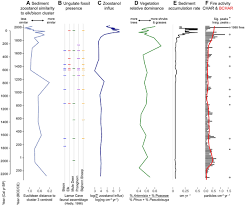Ancient Herbivore Presence in Yellowstone Uncovered Through Sediment Analysis

A new study published in *PLOS ONE* on October 30, 2024, reveals that large herbivores, including bison and elk, have continuously inhabited the Yellowstone National Park region for approximately 2,300 years. Led by John Wendt of Oklahoma State University, the research provides valuable insights into the ecological history of these species in an area heavily impacted by human activities in the 19th and 20th centuries.
The near-extinction of bison in North America represents a significant ecological disaster, leaving many questions about the distribution and lifestyle of these animals prior to European colonization. In this study, Wendt and colleagues sought to identify the dominant large herbivores that roamed the northern Yellowstone area by analyzing preserved steroids from animal dung found in lake sediments dating back to around 238 B.C.
To conduct their analysis, the researchers first identified the types of steroids present in the dung of various large herbivores believed to have inhabited the region, including bison, elk, moose, mule deer, and pronghorn. They found that while moose, pronghorn, and mule deer could be distinguished based on the steroids in their dung, bison and elk were more challenging to differentiate.
By examining the steroids across different sediment layers, the researchers determined that either bison, elk, or a combination of both had been the primary large herbivore species in the watershed over the last 2,300 years. Interestingly, the analysis revealed elevated steroid levels during the 20th century, a period marked by hunting restrictions, diminished winter migrations for bison and elk, and the eradication of their natural predators.
The study also indicated that the increased populations of these large herbivores likely overgrazed local forage plants, such as willow and Idaho fescue, and their dung may have contributed to the fertilization of diatom growth in the lake, thereby altering the local ecosystem. Additionally, provisions of winter hay supplied by park managers encouraged animals to remain in the area longer, further impacting the watershed.
This research illustrates that analyzing steroids in lake sediments is a promising method for wildlife managers and conservationists seeking to understand the historical dynamics of hoofed animal communities and their ecological impacts. While the study provides insights into a single watershed, the authors anticipate that applying this methodology across multiple sites could yield critical information about the past grazing communities at Yellowstone National Park and beyond.
The authors conclude, "We developed a 2,300-year record of wild herbivore activity in northern Yellowstone National Park with fossil biomarkers found in lake sediments. This information is critical for understanding long-term dynamics of ecologically and culturally important herbivores such as bison and elk."
Story Source:
Materials provided by PLOS. The original text of this story is licensed under a Creative Commons License. Note: Content may be edited for style and length.
Journal Reference:
- John A. F. Wendt, Elena Argiriadis, Cathy Whitlock, Mara Bortolini, Dario Battistel, David B. McWethy. A 2000-year record of fecal biomarkers reveals past herbivore presence and impacts in a catchment in northern Yellowstone National Park, USA. PLOS ONE, 2024; 19 (10): e0311950 DOI: 10.1371/journal.pone.0311950

0 Comments